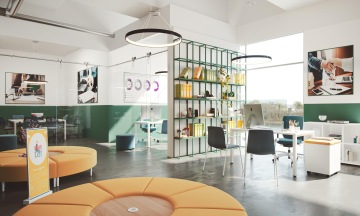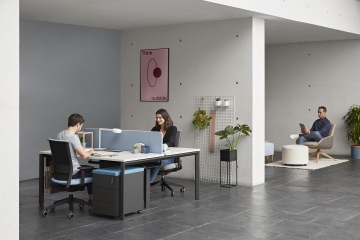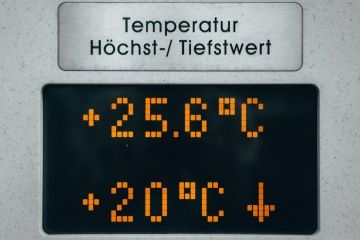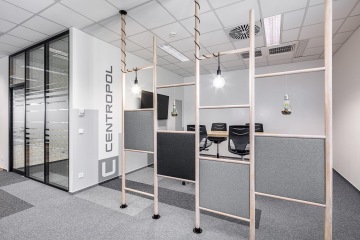Temperature control in the office: how to do it?

Heating and air conditioning are among the costliest and most energy intensive features of office buildings. The microclimate in the office also has a significant effect on the overall well-being and productivity of employees. Thermoregulation cannot therefore be neglected when designing office space. On the contrary, ensuring the right microclimate must be clearly at the forefront. Even in older buildings, whose thermoregulation is not ideal from a construction point of view, excellent results can be achieved through a cleverly laid out interior and by incorporating modern technologies. So how do you achieve a temperature in the office that will suit all employees?
What temperature is best for our body?

Balance
The first principle that we must keep in mind during the design of thermoregulatory solutions is that everyone is different in terms of their own thermal comfort. The body is happiest when there is a balance between the heat it produces and dissipates. This is a relatively narrow temperature range, outside which our body must cope with either heat or cold stress.

Stability
The main problem is that it is not possible to unify the heat production of individual employees. Even were we to introduce rules of work straight out of Orwell's 1984 (for example, every employee would wear exactly the same clothes and perform equally demanding tasks throughout the day), then the internal temperature of our body would still be affected by elements such as metabolism, fatigue or mental stress.
Yes, even the psyche can completely change our current temperature needs, especially negative mental phenomena such as stress. Surely you know the feeling of being overcome by heat, especially when you find yourself rushing to complete a demanding work task.
The law speaks for itself

Maximum 26°C
According to the law (Government Decree No. 361/2007 Coll.), the maximum permitted temperature in a space intended for office or administrative work is 26°C. This temperature limit is recommended in extreme summer temperatures of around 32°C, when the difference between indoor and outdoor temperature should not exceed 6°C. These are the conditions we work in when the temperatures reach extremes and at about 27°C we will keep the temperature in the room at what is for most people an acceptable 21 to 23°C.
In air-conditioned rooms, however, it's best not to set the thermostat too low on hot summer days. While a person coming out of the heat might appreciate a rapid and significant drop in temperature for a short time, regularly switching between places with
a temperature difference of more than 6°C can be harmful to health and cause colds.
Thermoregulation must be considered when designing a building

Start planning
Proper temperature control in a building depends on
a well-designed HVAC (heating, ventilation, and air conditioning) system, the architectural design of the building and its location. When choosing offices for rent, it is necessary to take into account whether the premises are located in a modern building equipped with, for example, angled façade elements, quality glazing with reflective elements to reflect heat on the exterior façade or window blinds that can effectively retain sunlight and reduce heat load inside.
Where these elements are missing, they can in many cases be retrofitted, but this is already a matter of agreement with the landlord and an investment from their point of view.
Temperature zones are a "an ideal solution"

Open space problem
Aware of the subjective nature of thermal well-being, we will realize that a large open space in which a uniform temperature is maintained can be problematic. Even in
a building that is equipped with active elements that prevent excessive heat accumulation, there will be disagreements between individual employees. A better solution is a more structured office that offers enough privacy and especially temperature zones.

Flexibility
Many companies today are abandoning the rigid system where each employee only works in one specific place. The principles of coworking and desk sharing (one workspace shared by multiple employees) have also entered classic corporate structures. In offices with various temperature zones, employees can freely switch workspaces during the day for one with the temperature that suits them best.
Of course, the creation of temperature zones requires a thorough survey of the space, the involvement of intelligent cooling technologies and feedback from individual employees so that the zones actually meet the required conditions. In short, the thermoregulation of office space must be tailor-made.
Do not underestimate humidity

Negative impacts
Subjective temperature is not the only element of the microclimate that affects our health and well-being. The temperature in the office must be supplemented by
a suitably selected humidity level. The relative humidity in the office should preferably be in the range of 30 to 70%.
If the humidity drops below 20%, employees' productivity will decrease, fatigue will set in, and the mucous membranes of the upper respiratory tract will dry, facilitating the penetration of harmful substances, viruses, and bacteria into the body.
Thermoregulation in the office is a complex field and an issue that we will be happy to advise you on. Today, healthy and productive employees are of the utmost value.
Authors of photographs: Unsplash, Petr Andrlík
Published August 17, 2020